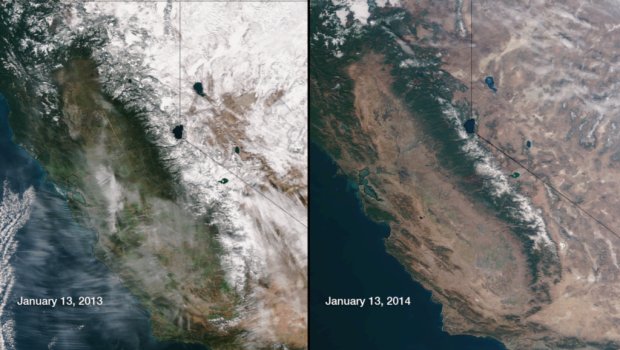
California has found itself in perhaps the most severe drought in the state’s history, with two-thirds of the state being designated as “extreme drought.” On January 19, 2014, state Governor Jerry Brown declared a drought emergency and urged residents to reduce water consumption by 20 percent. Rainfall, snow pack, river, and lake levels are all short of where they should be at this time of the year. Concern is growing as millions of Californians may soon find themselves without a reliable supply of water. State water officials announced they would not be sending any state water to local agencies servicing 25 million residents and 750,000 acres of farmland unless the drought weakens. To make matters even more bleak, California’s wet season is almost over and the dry summer months are on the horizon.
According to an article reported by ABC, “This past week, the snow pack’s water content was measured at 12 percent of normal. State officials announced that they would not be sending water to California’s agricultural customers. US officials are expected in late February to announce they will allot only a fraction of the federally controlled water that farmers want, if any.” This stark announcement is not only bad news for farmers, it is downright depressing. California’s agricultural industry is bracing for a horrible year; many farmers are already preparing for food stamps and unemployment. Some farmers are opting to leave their fields fallow this year, which will inevitably impact food supply and prices. However, the agriculture is not the only industry that will be affected by the lack of water. Countless jobs depend on farming activities, and a ripple effect will soon be felt throughout the Central Valley and beyond.
In response to the dire situation, many people are blaming Washington for failed regulatory decisions. Republican representatives are calling for legislation that would allocate available water resources by means of redistribution, but the proposed bill would, “among other things, roll back environmental protections and halt restoration of a dried-up stretch of the San Joaquin River that is designed to revive salmon runs.” While most farmers would welcome such aid, environmentalists argue that all the hard work they have devoted to restoring aquatic ecosystems would get pushed to the side, thus failing legislative initiatives that have already been established. Environmentalists described the moves as being a “wholesale assault on California’s environment, native fisheries, and the thousands of jobs that depend on healthy fisheries and rivers, while providing no durable solutions to effectively addressing California’s water needs.”
So what’s the plan? Governor Brown has voiced support for a $15 billion tunnel that would transfer water from the Sacramento River to cities and farms in the south. Construction would not begin until 2017 and faces numerous legislative hurdles along the way. One of the underlying issues with the tunnel is that it does not facilitate conservation, merely distribution. Straining a resource in the north in order to aid populations to the south is not a sustainable model and is already facing plenty of critics. According to an article posted by Bloomberg, “The governor’s tunnels are based on flawed and outdated assumptions that there is ‘surplus’ water to export,” said Barbara Barrigan-Parrilla, executive director Restore the Delta, a group that opposes the plan. “We have had three dry years in a row and the governor admits the tunnels won’t add one drop of water to our drought-plagued state.”
Jordan Schmidt 
Editor
jschmidt@banksinfo.com
Image source: NOAA/NASA
